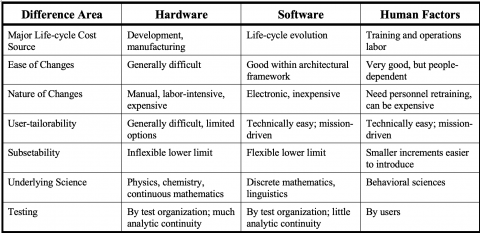Introduction
Many projects have difficulties in integrating their hardware, software, and human factors aspects. This is basically due to differences between these aspects with respect to their underlying economics, evolution patterns, product subsetability (ability to deliver usable partial initial operational capabilities), user tailorability, adaptability, underlying science, and testing considerations, as summarized in Table 1.
This paper begins by summarizing trends that have caused difficulties for current systems engineering and acquisition processes (complex multi-owner systems of systems (SoS), emergent requirements, rapid change, reused components, high assurance of qualities) and principles underlying the ICM that better address these trends (stakeholder satisficing, incremental and evolutionary growth of system definition and stakeholder commitment, iterative development, concurrent definition and development, and risk management). It then presents several complementary views of the ICM, discusses their implications with respect to acquisition and engineering practices and personnel career paths, and assesses project performance with respect to use of the principles. The principles can also be used to avoid the negative effects of common misinterpretations of other current models such as the V, spiral, and Rational Unified Process (RUP) models.
Defines standard
Replaced/Superseded by document(s)
Cancelled by
Amended by
| File | MIME type | Size (KB) | Language | Download | |
|---|---|---|---|---|---|
| 4-ICM Tech Report USC-CSSE-2007-715.doc | application/msword | 410 KB | English | DOWNLOAD! |
Provides definitions
Publisher
Center for Systems and Software Engineering

